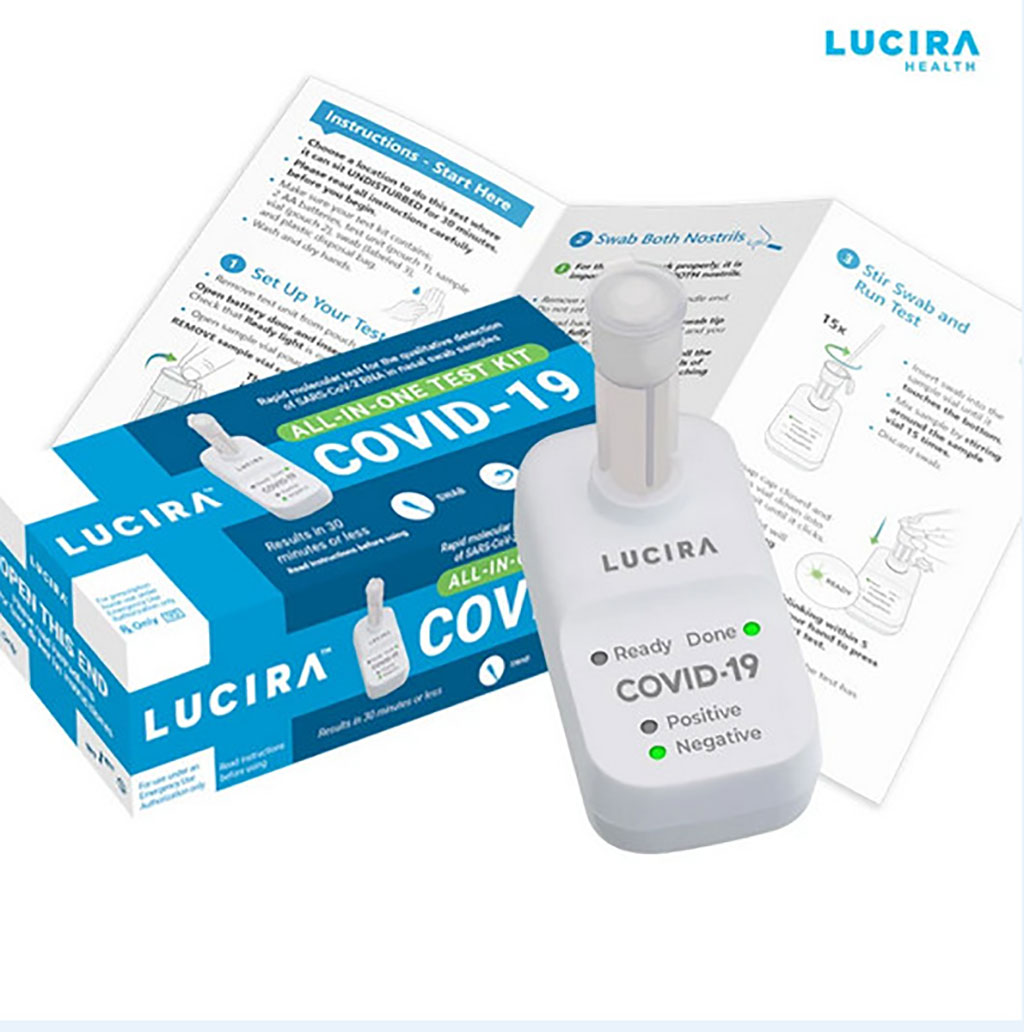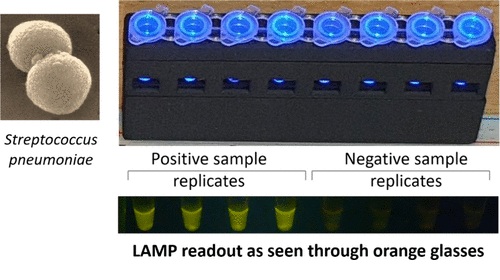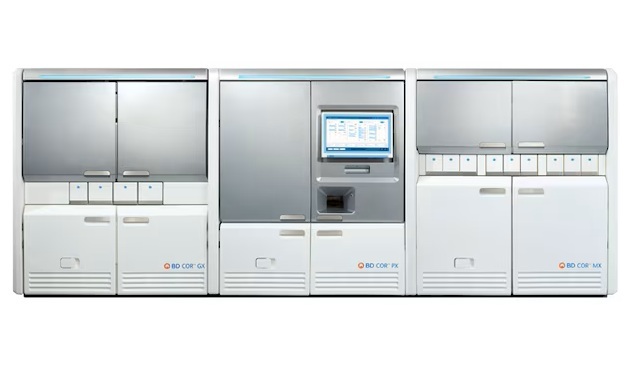New All-in-One COVID-19 Test Kit Identifies 99.9% of All Known SARS-CoV-2 Strains
|
By LabMedica International staff writers Posted on 12 Apr 2021 |

Image: LUCIRA COVID-19 All-In-One Test Kit (Photo courtesy of Lucira Health, Inc.)
A COVID-19 molecular test kit can successfully identify the “double mutant” variant of the SARS-CoV-2 virus.
Lucira Health, Inc.’s (Emeryville, CA, USA) single-use COVID-19 All-In-One Test Kit has been found to be reactive to at least 99.9% of all known SARS-CoV-2 strains. The “double mutant” variant was first identified in India on March 24, 2021, and found in California on March 25, 2021, by Stanford Clinical Virology Lab scientists. Unlike other variants, it has two genetic mutation sequences that the Center for Disease Control (CDC) is tracking. Variants occur when viruses replicate themselves and include well-known strains first discovered in the UK, South Africa, and Brazil. Variants can occur when the genetic code packaged inside the virus starts copying itself and the new copies inadvertently start replicating a new, mutant code. These errors can cause a virus to elude the immune system and become more challenging to detect.
The targeted, molecular amplification that LUCIRA COVID-19 All-In-One Test Kit and PCR tests employ makes them demonstrably more sensitive and reliable than “rapid” antigen tests, which can miss active COVID-19 infections. The LUCIRA COVID-19 All-In-One Test Kit Test Kit fits in the palm of a hand, extracts genetic material from the virus and amplifies it similar to PCR lab tests. Each Lucira test kit contains everything needed to run one COVID-19 test. Users get the test device, two AA batteries, sample vial, swab and simple instructions. The batteries are inserted into the device and the sample vial is placed in the test unit. The user then opens the test swab packet and rotates the swab in each nostril five times. The swab is then stirred in the sample vial, which is then gently pressed into the test unit to start the test. The “ready” light will blink until a “positive” or “negative” green light is illuminated within 30 minutes. Lucira’s easy-to-use ‘swab, stir and detect’ test platform demonstrated that 100% of users successfully performed the test in less than about two minutes of hands-on time in usability testing.
“A test is only helpful if it can detect the virus it’s designed to find. That’s why we started routinely monitoring COVID-19 viral variants, even before the FDA’s voluntary guidelines were released this February. As sequences from new virus strains become available, we compare their genetic code with our test using a well-established, extremely accurate computer model,” said Lucira Health Chief Technology Officer and co-founder Debkishore Mitra, Ph.D. “Since we began this monitoring, our Lucira test kit has been reactive to more than 99.9% of available COVID-19 viral sequences, which are roughly 30,000 letters long. It’s complex work, but really important since users rely on our test for accurate results.”
“Our focus is on providing a test that’s easy for an individual to use and extremely accurate. If someone uses our ‘gentle swab’ test and has COVID-19, they can know in as few as 11 minutes on-the-spot. If they are not infected, they will know within 30 minutes. Precision and performance matter, and we can’t afford to let any variants escape detection,” Dr. Mitra added.
Related Links:
Lucira Health, Inc.
Lucira Health, Inc.’s (Emeryville, CA, USA) single-use COVID-19 All-In-One Test Kit has been found to be reactive to at least 99.9% of all known SARS-CoV-2 strains. The “double mutant” variant was first identified in India on March 24, 2021, and found in California on March 25, 2021, by Stanford Clinical Virology Lab scientists. Unlike other variants, it has two genetic mutation sequences that the Center for Disease Control (CDC) is tracking. Variants occur when viruses replicate themselves and include well-known strains first discovered in the UK, South Africa, and Brazil. Variants can occur when the genetic code packaged inside the virus starts copying itself and the new copies inadvertently start replicating a new, mutant code. These errors can cause a virus to elude the immune system and become more challenging to detect.
The targeted, molecular amplification that LUCIRA COVID-19 All-In-One Test Kit and PCR tests employ makes them demonstrably more sensitive and reliable than “rapid” antigen tests, which can miss active COVID-19 infections. The LUCIRA COVID-19 All-In-One Test Kit Test Kit fits in the palm of a hand, extracts genetic material from the virus and amplifies it similar to PCR lab tests. Each Lucira test kit contains everything needed to run one COVID-19 test. Users get the test device, two AA batteries, sample vial, swab and simple instructions. The batteries are inserted into the device and the sample vial is placed in the test unit. The user then opens the test swab packet and rotates the swab in each nostril five times. The swab is then stirred in the sample vial, which is then gently pressed into the test unit to start the test. The “ready” light will blink until a “positive” or “negative” green light is illuminated within 30 minutes. Lucira’s easy-to-use ‘swab, stir and detect’ test platform demonstrated that 100% of users successfully performed the test in less than about two minutes of hands-on time in usability testing.
“A test is only helpful if it can detect the virus it’s designed to find. That’s why we started routinely monitoring COVID-19 viral variants, even before the FDA’s voluntary guidelines were released this February. As sequences from new virus strains become available, we compare their genetic code with our test using a well-established, extremely accurate computer model,” said Lucira Health Chief Technology Officer and co-founder Debkishore Mitra, Ph.D. “Since we began this monitoring, our Lucira test kit has been reactive to more than 99.9% of available COVID-19 viral sequences, which are roughly 30,000 letters long. It’s complex work, but really important since users rely on our test for accurate results.”
“Our focus is on providing a test that’s easy for an individual to use and extremely accurate. If someone uses our ‘gentle swab’ test and has COVID-19, they can know in as few as 11 minutes on-the-spot. If they are not infected, they will know within 30 minutes. Precision and performance matter, and we can’t afford to let any variants escape detection,” Dr. Mitra added.
Related Links:
Lucira Health, Inc.
Latest COVID-19 News
- New Immunosensor Paves Way to Rapid POC Testing for COVID-19 and Emerging Infectious Diseases
- Long COVID Etiologies Found in Acute Infection Blood Samples
- Novel Device Detects COVID-19 Antibodies in Five Minutes
- CRISPR-Powered COVID-19 Test Detects SARS-CoV-2 in 30 Minutes Using Gene Scissors
- Gut Microbiome Dysbiosis Linked to COVID-19
- Novel SARS CoV-2 Rapid Antigen Test Validated for Diagnostic Accuracy
- New COVID + Flu + R.S.V. Test to Help Prepare for `Tripledemic`
- AI Takes Guesswork Out Of Lateral Flow Testing
- Fastest Ever SARS-CoV-2 Antigen Test Designed for Non-Invasive COVID-19 Testing in Any Setting
- Rapid Antigen Tests Detect Omicron, Delta SARS-CoV-2 Variants
- Health Care Professionals Showed Increased Interest in POC Technologies During Pandemic, Finds Study
- Set Up Reserve Lab Capacity Now for Faster Response to Next Pandemic, Say Researchers
- Blood Test Performed During Initial Infection Predicts Long COVID Risk
- Low-Cost COVID-19 Testing Platform Combines Sensitivity of PCR and Speed of Antigen Tests
- Finger-Prick Blood Test Identifies Immunity to COVID-19
- Quick Test Kit Determines Immunity Against COVID-19 and Its Variants
Channels
Clinical Chemistry
view channel
VOCs Show Promise for Early Multi-Cancer Detection
Early cancer detection is critical to improving survival rates, but most current screening methods focus on individual cancer types and often involve invasive procedures. This makes it difficult to identify... Read more
Portable Raman Spectroscopy Offers Cost-Effective Kidney Disease Diagnosis at POC
Kidney disease is typically diagnosed through blood or urine tests, often when patients present with symptoms such as blood in urine, shortness of breath, or weight loss. While these tests are common,... Read moreMolecular Diagnostics
view channel
New Diagnostic Method Detects Pneumonia at POC in Low-Resource Settings
Pneumonia continues to be one of the leading causes of death in low- and middle-income countries, where limited access to advanced laboratory infrastructure hampers early and accurate diagnosis.... Read more
Blood Immune Cell Analysis Detects Parkinson’s Before Symptoms Appear
Early diagnosis of Parkinson’s disease remains one of the greatest challenges in neurology. The condition, which affects nearly 12 million people globally, is typically identified only after significant... Read moreHematology
view channel
ADLM’s New Coagulation Testing Guidance to Improve Care for Patients on Blood Thinners
Direct oral anticoagulants (DOACs) are one of the most common types of blood thinners. Patients take them to prevent a host of complications that could arise from blood clotting, including stroke, deep... Read more
Viscoelastic Testing Could Improve Treatment of Maternal Hemorrhage
Postpartum hemorrhage, severe bleeding after childbirth, remains one of the leading causes of maternal mortality worldwide, yet many of these deaths are preventable. Standard care can be hindered by delays... Read more
Pioneering Model Measures Radiation Exposure in Blood for Precise Cancer Treatments
Scientists have long focused on protecting organs near tumors during radiotherapy, but blood — a vital, circulating tissue — has largely been excluded from dose calculations. Each blood cell passing through... Read moreImmunology
view channel
Blood-Based Liquid Biopsy Model Analyzes Immunotherapy Effectiveness
Immunotherapy has revolutionized cancer care by harnessing the immune system to fight tumors, yet predicting who will benefit remains a major challenge. Many patients undergo costly and taxing treatment... Read more
Signature Genes Predict T-Cell Expansion in Cancer Immunotherapy
Modern cancer immunotherapies rely on the ability of CD8⁺ T cells to rapidly multiply within tumors, generating the immune force needed to eliminate cancer cells. However, the biological triggers behind... Read moreMicrobiology
view channel
High-Throughput Enteric Panels Detect Multiple GI Bacterial Infections from Single Stool Swab Sample
Gastrointestinal (GI) infections are among the most common causes of illness worldwide, leading to over 1.7 million deaths annually and placing a heavy burden on healthcare systems. Conventional diagnostic... Read more
Fast Noninvasive Bedside Test Uses Sugar Fingerprint to Detect Fungal Infections
Candida bloodstream infections are a growing global health threat, causing an estimated 6 million cases and 3.8 million deaths annually. Hospitals are particularly vulnerable, as weakened patients after... Read morePathology
view channel
New Molecular Analysis Tool to Improve Disease Diagnosis
Accurately distinguishing between similar biomolecules such as proteins is vital for biomedical research and diagnostics, yet existing analytical tools often fail to detect subtle structural or compositional... Read more
Tears Offer Noninvasive Alternative for Diagnosing Neurodegenerative Diseases
Diagnosing and monitoring eye and neurodegenerative diseases often requires invasive procedures to access ocular fluids. Ocular fluids like aqueous humor and vitreous humor contain valuable molecular information... Read moreTechnology
view channel
Cell-Sorting Device Uses Electromagnetic Levitation to Precisely Direct Cell Movement
Sorting different cell types—such as cancerous versus healthy or live versus dead cells—is a critical task in biology and medicine. However, conventional methods often require labeling, chemical exposure,... Read more
Embedded GPU Platform Enables Rapid Blood Profiling for POC Diagnostics
Blood tests remain a cornerstone of medical diagnostics, but traditional imaging and analysis methods can be slow, costly, and reliant on dyes or contrast agents. Now, scientists have developed a real-time,... Read moreIndustry
view channel
Qiagen Acquires Single-Cell Omics Firm Parse Biosciences
QIAGEN (Venlo, Netherlands) has entered into a definitive agreement to fully acquire Parse Biosciences (Seattle, WA, USA), a provider of scalable, instrument-free solutions for single-cell research.... Read more
Puritan Medical Products Showcasing Innovation at AMP2025 in Boston
Puritan Medical Products (Guilford, ME, USA), the world’s most trusted manufacturer of swabs and specimen collection devices, is set to exhibit at AMP2025 in Boston, Massachusetts, from November 11–15.... Read more
Advanced Instruments Merged Under Nova Biomedical Name
Advanced Instruments (Norwood, MA, USA) and Nova Biomedical (Waltham, MA, USA) are now officially doing business under a single, unified brand. This transformation is expected to deliver greater value... Read more

























